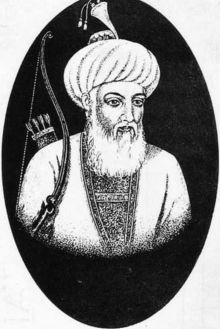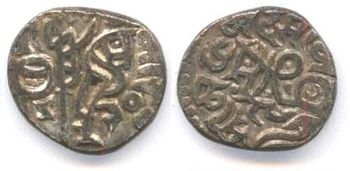السلطان محمد الغوري (الهند)
السلطان شهاب الدين محمد الغوري وكان اسمه قبل الحكم: معز الدين محمد بن سام (1162 - 15 مارس 1206) بالإنجليزية Muhammad Shahab ud-Din Ghori ، هو السلطان معز الدين محمد الغوري ، هو مؤسس الدولة الغورية (1148-1215) التي قامت على أنقاض الدولة الغزنوية التي كانت تملك بلاد الغور والأفغان والهند الشمالية. ومن هنا جاء لقبه وكان يتحدث اللغة الفارسية.[1][2] was a ruler from the Ghurid dynasty based in what is today Afghanistan who ruled from 1173 CE to 1206 CE. He extended the Ghurid dominions eastwards and laid the foundation of Islamic rule in the Indian Subcontinent, which lasted after him for nearly half a millennium. During his joint reign with his brother Ghiyasuddin Ghori (r. c. 1163–1203), the Ghurids reached the epogee of their territorial expansion.
| معز الدين محمد بن سام | |
|---|---|
| سلطان الدولة الغورية | |
 سلطان شہاب الدین محمد غوری | |
| العهد | 1202–1206 |
| سبقه | غياث الدين محمد بن سام |
| تبعه | قطب الدين أيبك |
| وُلِد | 1150 غور في أفغانستان الحالية |
| توفي | 15 مارس 1206 Damiak, ضلع جهيلوم، پاكستان |
| الدفن | Damik, ضلع جهيلوم، پاكستان |
| البيت | الأسرة الغورية |
| الأب | الملك بهاء الدين سام بن حسين |
| الديانة | مسلم سني |
During his early military career as a prince and governor of the southern tract of the Ghurid Empire, Muhammad subjugated the Oghuz tribe after multiple raids and captured Ghazna where he was crowned by his brother Ghiyasuddin Ghori, who was ruling from his capital Firozkoh since 1163. Muhammad of Ghor crossed the Indus River in 1175, approaching it through Gomal Pass and captured Multan and Uch from the Qarmatīa rulers within a year. Afterwards, Muhammad marched via Multan and Uch into present-day Gujarat in 1178, where his forces were routed at the foot of Mount Abu in the southern Aravali ranges by a coalition of Rajput chiefs led by Mularaja Solanki of Anhilwara, which forced him to change his route for future inroads into India. Hence, Muhammad of Ghor pressed upon the Ghaznawids, and uprooted them by 1186, conquering the upper Indus Plain along with most of the Punjab. After consolidating his hold in northwest, Muhammad of Ghor, penetrated through the traditional route of Khyber Pass into northern India.
In 1191, his forces were defeated by a Rajput Confederacy led by Prithviraj Chauhan near Tarain. However, in 1192, Muhammad of Ghor returned with a vast army of Turkish mounted archers and secured a decisive victory on the same battleground and executed Prithviraj shortly afterwards. His victory at Tarain marked a watershed in medieval history of India. He concentrated thereafter on expansion in the west along with raiding in northern India from his base in Ghazna and left his conquests in India to his slave generals who swiftly raided local kingdoms and expanded the influence of the Ghurids until Bengal in the east.
After the death of his brother in 1203, Muhammad of Ghor ascended the throne of Fīrōzkōh as well. Within a year or so in conflict with the Khwarazmian Empire, he suffered a disastrous defeat in the Battle of Andkhud against the Qara-Khitai forces (came in as aid of Khwarazmian Empire) led by Tayangu which halted his expansion in Central Asia and resulted in the loss of Merv and most of the Khorasan. Muhammad of Ghor suppressed the rebels which arose after the defeat and built a boat bridge across the Oxus to launch a full-scale invasion of Transoxiana to avenge his defeat, although a rebellion by the Khokhars forced him to move towards Punjab, where he brutually crushed the Khokhar revolt during his last campaign.
On his way back, Muhammad of Ghor was assassinated on the bank of Indus at Damyak on 15 March 1206, by a group of assassins from the rival Ismāʿīlīyah sect while offering the evening prayer. After his death, his empire fragmented amidst the rise of Khwarazmian Empire under Muhammad II of Khwarezm who overthrew the Ghurids by 1215. His conquests in the Indian Subcontinent, although continued to thrive under the Mamlūk dynasty established by his slave commander Qutb ud-Din Aibak.
في عام 1206، ذهب إلى لاهور للقضاء على تمرد الخخار الهندوس. وبعد إخماده التمرد بقتل عشرات الآلاف من الخخار، أقفل عائداً إلى غزنة. وفي طريق عودته توقف للراحة في دامق، بالقرب من مدينة جهيلوم في مقاطعة الپنجاب. وأثناء صلاته صلاة العشاء قتله هندوسي من الخخار انتقاماً لقتله عشرات الآلاف منهم. وينسب بعض المؤرخين القاتل إلى جماعة گخار الهندوية المحلية، بدلاً من الخخار في لاهور. وبعض المؤخين ينسبون القاتل للحشاشين من الطائفة الإسماعيلية.
. . . . . . . . . . . . . . . . . . . . . . . . . . . . . . . . . . . . . . . . . . . . . . . . . . . . . . . . . . . . . . . . . . . . . . . . . . . . . . . . . . . . . . . . . . . . . . . . . . . . . . . . . . . . . . . . . . . . . . . . . . . . . . . . . . . . . . . . . . . . . . . . . . . . . . . . . . . . . . . . . . . . . . . .
انظر أيضا
قراءات إضافية
- Elliot, Sir H. M., Edited by Dowson, John. The History of India, as Told by Its Own Historians. The Muhammadan Period; published by London Trubner Company 1867–1877. (Online Copy: The History of India, as Told by Its Own Historians. The Muhammadan Period; by Sir H. M. Elliot; Edited by John Dowson; London Trubner Company 1867–1877 - This online Copy has been posted by: The Packard Humanities Institute; Persian Texts in Translation; Also find other historical books: Author List and Title List)
المصادر
- John Keay (2001). India: A history. Grove Press; 1 Grove Pr edition. ISBN 0-8021-3797-0.
{{cite book}}: Unknown parameter|month=ignored (help)
- ^ Encyclopaedia Iranica, "Ghurids", C.E. Bosworth, (LINK): "... The Ghurids came from the Šansabānī family. The name of the eponym Šansabānasb probably derives from the Middle Persian name Wišnasp (Justi, Namenbuch, p. 282). [...] Nor do we know anything about the ethnic stock of the Ghori's in general and the Sansabanis in particular; We can only assume that they were eastern Iranian Tajiks ... The sultans were generous patrons of the Persian literary traditions of Khorasan, and latterly fulfilled a valuable role as transmitters of this heritage to the newly conquered lands of northern India, laying the foundations for the essentially Persian culture which was to prevail in Muslim India until the 19th century. ..."
- ^ Encyclopaedia of Islam, "Ghurids", C.E. Bosworth, Online Edition, 2006: "... The Shansabānīs were, like the rest of the Ghūrīs, of eastern Iranian Tājik stock. ..."

